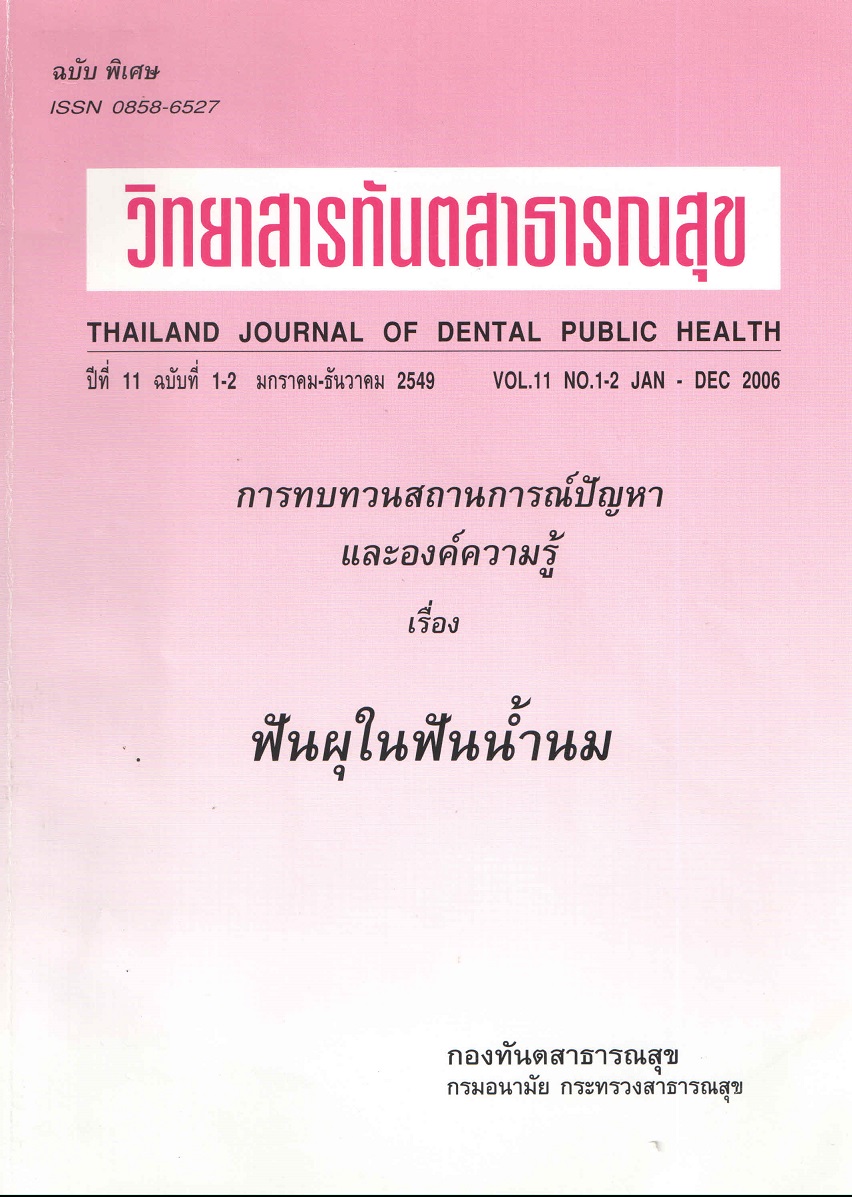การควบคุมแบคทีเรียก่อโรคฟันผุ (Control of cariogenic bacteria)
Main Article Content
Abstract
เป็นที่ยอมรับว่าโรคฟันผุเป็นโรคติดเชื้อสามารถติดต่อแพร่กระจายได้ พบว่าสาเหตุสำคัญประการหนึ่งของการเกิดโรคฟันผุคือ มิวแทนส์ สเตร็ปโตค็อกไซ (mutans streptococci) ซึ่งพบได้ในช่องปากของเด็กตั้งแต่เริ่มมีฟันขึ้นเนื่องจากเชื้อ มิวแทนส์ สเตร็ปโตค็อกไซ มีคุณสมบัติที่แตกต่างจากเชื้อชนิดอื่นในช่องปาก เช่น สามารถสร้างดพลีแซคคาไรด์ชนิดที่ไม่ละลายน้ำซึ่งเป็นส่วนประกอบสำคัญของคราบจุลินทรีย์สร้างกรดและทนกรดได้ดี เป็นต้น อัตราการติดเชื้อ มิวแทนส์ สเตร็ปโตค็อกไซ จะเพิ่มขึ้นตามอายุและจำนวนฟันที่ขึ้นมาในช่องปาก โดยช่วงอายุ ที่เริ่มตรวจพบ มิวแทนส์ สเตร็ปโตค็อกไซ ในช่องปากสามารถใช้ทำนายโอกาสของการเกิดรอยโรคฟันผุในเวลาต่อมา ยิ่งพบว่ามิวแทนส์ สเตร็ปโตค็อกไซ เข้ามาอยู่ในช่องปาก ได้เร็วเท่าใด จะยิ่งมีโอกาสเกิดโรคฟันผุสูงขึ้นเท่านั้น การแพร่กระจายเชื้อส่วนใหญ่เกิดขึ้นโดยทางน้ำลายแม้ได้รับเชื้อในปริมาณไม่มาก และเกิดขึ้นได้ง่ายหากได้รับเชื้อซ้ำๆบ่อยครั้ง การควบคุมปริมาณของ มิวแทนส์ สเตร็ปโตค็อกไซ ในช่องปากจึงจัดว่าเป็นวิธีที่มีประสิทธิภาพในการป้องกันโรคฟันผุ นับตั้งแต่การลดการส่งผ่านเชื้อที่จะแพร่กระจายไปสู่เด็ก โดยมุ่งเน้นที่แม่ซึ่งเชื่อว่าเป็นแหล่งแพร่กระจายเชื้อสำคัญที่สุด นอกจากนี้ยังมีการพัฒนาวัคซีน เพื่อนำมาใช้กระตุ้นให้สร้างภูมิคุ้มกันโรค การให้แอนติบอดีซึ่งเป็นภูมิคุ้มกันโรคโดยตรง การให้การรักษาแทนที่โดย การใช้เชื้ออ่อนฤทธิ์เข้าไปแทนที่เชื้อก่อโรคในช่องปาก และ การยับยั้งการก่อตัวของคราบจุลินทรีย์ รวมทั้งการเสริมความต้านทานโดยการสังเคราะห์โปรตีนในน้ำลายชนิดต่างๆที่มีฤทธิ์ต้านจุลินทรีย์ เพื่อนำมาเติมลงในน้ำยาบ้วนปาก หรือยาสีฟัน เพื่อป้องกันโรคฟันผุ
Downloads
Article Details
References
2. Tenovuo J, Hakkinen P, Paunio P, Emilson CG. Effects of chlorhexidine-fluoride gel treatments in mothers on the establishment of mutans streptococci in primary teeth and the development of dental caries in children. Caries Res 1992;26:275-80.
3. Kohler B, Andreen I. Influence of caries-preventive measures in mothers on cariogenic bacteria and caries experience in their children. Arch Oral Biol 1994;39:907-11.
4. Soderling E, Isokangas P, Pienihakkinen K Tenovuo J. Influence of maternal xylitol consump tion on acquisition of mutans streptococci by infants. J Dent Res 2000;79:882-7.
5. Soderling E, Isokangas P, Pienihakkinen K, Tenovuo J, Alanen P. Influence of maternal xylitol consumption on mother-child transmission of mutans streptococci :6-year follow-up. Caries Res 2001 ;35:173-177.
6. Bratthall D, Serinirach R, Rapisuwon S, Kuratana M, Luangjarmekorn V, Laksila K, et al. A study into the prevention of fissure caries using and antimicrobial varnish. Int Dent J 1995,45:245-54.
7. Lopez L, Berkowitz R, Zlotnik H, Moss M, Weinstein P. Topical antimicrobial therapy in the prevention of early childhood caries. Pediatr Dent 1999;21:9-11.
8. Lehner T, Russell MW, Caldwell J, Smith R. Immunization with purified protein antigens from Streptococcus mutans against dental caries in rhesus monkeys. Infect Immun 1981; 34: 407-15.
9. Talbman MA, Smith DJ. Effects of local immunization with Streptococcus mutans on induction of salivary immunoglobulin A antibody and experimental dental caries in rats. Infect Immun 1974; 9: 1079-91.
10. Taubman MA. Vaccination: a cariostatic option? In: Bowen WH, Tabak LA, eds. Cariology for the nineties. Rochester, New York : University of Rochester Press; 1993. p. 441-57.
11. Ma JK, Lehner T. Prevention of colonization of Streptococcus mutans by topical application of monoclonal antibodies in human subjects. Arch Oral Biol 1990; 35: 1155-122s.
12. Ma JK, Smith JK, Lehner T. Use of monoclonal antibodies in local passive immunization to prevent colonization of human teeth by Streptococcus mutans. Infect Immun 1987; 55: 1274-8.
13. Michalek SM, Gregory RL, Harmon CC, et al. Protection of gnotobiotic rats against dental caries by passive immunization with bovine milk antibodies to Streptococcus mutans. Infect Immun 1987; 55: 2341-7.
14. Filler SJ, Gregory RL, Michalek SM, Katz J, McGhee JR. Effect of immune bovine milk on Streptococcus mutans in human dental plaque. Arch Oral Biol 1991;36: 41-7.
15. Hillman JD, Duncan MJ, Stashenko KP. Cloning and expression of the gene encoding the fructose-1,6-diphosphate-dependent L-(+)-lactate dehydrogenase of Streptococcus mutans. Infect Immun 1990; 58:1290-5.
16. Marquis R. Arginine deaminaseand alkali generation in plaque. In: bowen WH, Tabak LA, eds. Cariology for the nineties. Rochester, New York: University of Rochester Press 1993. p. 30917.
17. Kubo S, Kubota H, Ohnishi Y, Morita T, Matsuya T, Mutsushiro A. Expression and secretion of an Arthrobacter dextranase in the oral bacterium Streptococcus gordonii. Infect Immun 1993; 61: 4375-81.
18. Tabak LA. In defense of the oral cavity: structure, biosynthesis and function of salivary mucins. Annu Rev Physiol 1995; 57: 547-64. Suhonen J, Sener B, Bucher W, Lutz F. Release of preventive agents from pacifiers in vitro. An introduction to a novel preventive measure. Schweiz Monatsschr Zahnmed. 1994;104:946-51.


